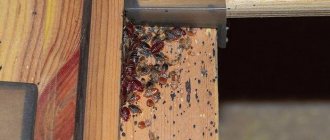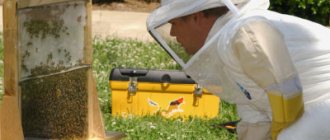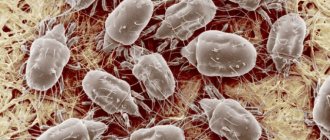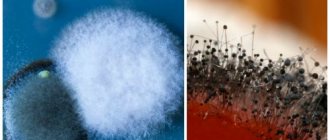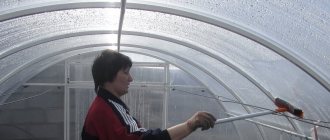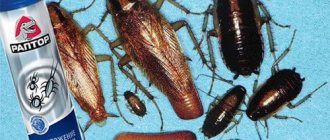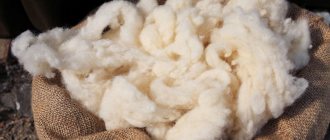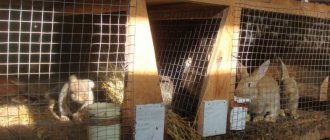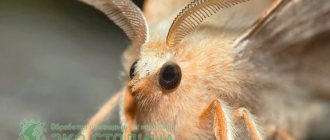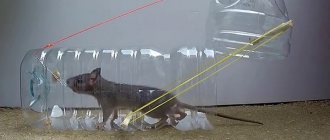For the quality functioning of the apiary, the beekeeper needs to take into account many factors, timely carry out all work on caring for houses, insects, preventing diseases, and preparing food. An important part of the beekeeper’s work is the process of uniting bee colonies, which helps strengthen the individuals and make them more productive.
Why is family unification necessary?
Weak families without a healthy uterus have no right to independent existence - this is an axiom for any beekeeper. It is impossible to take profit from a hive inhabited by such a swarm. At the same time, in order for the family to survive in winter, it will have to be provided with enough food. The problem can be solved by uniting two weak families into a strong one, capable of providing themselves with food, enduring the winter cold and subsequently bringing the beekeeper maximum product.
The merger is carried out to achieve the following goals:
- correction of queenless nests in the spring;
- running two-family farms in the summer;
- strengthening of promising families due to brood from auxiliary layerings.
A special type of association is the strengthening of nests by a swarming group or the joining of smaller swarms into an entire, strong family.
Proper transplantation of individuals
To prevent swarming and the gathering of families in the fall, and to form a strong and productive hive, you can perform a special unification using transplantation. Proper integration of swarms and families can be accomplished by mixing the honey that was stored in the two hives. Thus, the beekeeper gives the insects an odor foreign to them, which in the future will be perceived as their own. After the transplant, the two families will perceive themselves as one whole. The next stage is the mandatory replacement of the mother with a young, new queen.
It is important! The main rule should be followed when transplanting families. The procedure is performed when both families are weak
This is done for various reasons, but mainly to survive the winter. There is no need to touch numerous, strong families, since their unification will not bring any benefit or effectiveness.
Basic rules of association
The difficulty in the process of bringing together bees from different families is the hostile attitude of insects from different “collectives” towards each other. “Working women” are especially aggressive towards someone else’s womb. Bees identify strangers by smell, since each colony has its own unique scent.
In order for the unification to be successful and not end in a mortal battle, it is worth taking into account this feature of insects, as well as adhering to the following recommendations:
- carry out the main actions in the evening, when the flying bees have finished their working day;
- choose dry, windless weather;
- both families should be well-fed;
- Move the weak nest to the strong one in the hive.
- immediately before joining, spray the homes of both families with odorous substances so that they acquire a uniform smell.
What is prohibited to do:
- sick bees should not be placed in a healthy hive;
- You cannot combine bees of different breeds and races, or add an aggressive swarm to a calm, peace-loving one;
- Merging cannot be carried out in cold weather, when the average daily air temperature is below + 5 degrees.
Even if the above conditions are met, the uterus must be covered with a protective cap during the union. This is especially important when two strong families merge.
Expert opinion
Smirnov Dmitry Filipovich
Experienced beekeeper who knows everything about honey and the life of bees
If it is necessary to carry out a merger during a non-grace period, you need to work with the utmost caution. Inept actions and carelessness will lead in this situation to theft and excessive aggression.
Precautionary measures
Expanding housing conditions for joint families usually does not cause difficulties, but beekeepers should adhere to several conditions:
- Bees should not be stressed or brought together in bad weather (cold, damp...);
- Transplantation should be carried out among insects of the same breed, in order to avoid bullying and a healthy gene pool;
- You always need to monitor the queen and even during nesting she needs to be looked after and fed, otherwise she will die.
These are the main mistakes that can be made during the initial transplant of 2 families. Also, do not forget about possible “quarrels” within the new family, so you need to monitor the house every day so that there is no rebellion.
How to choose a favorable time
Any time of the year is suitable for merging families, but experienced beekeepers advise doing this in the spring, as soon as the hives are moved from wintering to the apiary.
The advantage of spring events is obvious:
- the new family will give more money than the old one;
- bees that survive the winter lose their ability to reproduce and, accordingly, their aggressiveness;
- the family’s own smell is quite weak and protective instincts are not yet developed;
- young bees still do not remember their hive well, so they willingly flock to a new place of residence.
It is especially recommended to carry out the union in the spring for families with dead or weakened queens. In the new team, the worker bees will immediately join the work process and significantly increase the size of the bribe.
Autumn unification is carried out if weakened families are found that are not destined to survive the winter. But for this time of year there is a significant limitation. In the spring, you can unite 2 weak families; in the fall, this is strictly prohibited.
The hive must leave for the winter with a sufficient supply of food, so a weak family is placed with a strong one, subject to several conditions:
- Bees of both families must be absolutely healthy.
- The hive must have a strong, viable queen.
- The bees should have enough food left to last throughout the winter. If there is a deficiency, fertilizing is carried out.
If any of the conditions do not meet the requirements, the colony will not survive the winter cold. But even a surviving swarm will not be able to collect nectar and provide the beekeeper with a sufficient amount of honey.
Weekend beekeeping
The famous beekeeper by the name of Tsebro developed his own method of breeding bees, the main principles of which are listed below.
- For their comfortable stay, they need spacious three-hull houses, which are called the Zerbo hive.
- Only strong groups should be in the apiary, and weak and sick ones should be removed immediately.
- Strong communities need to be well-nourished, so frames of beebread and honey should be left for them.
- Pay attention to how insects hibernate, because the productivity of the summer season directly depends on this.
- A new queen with layering is introduced into the family after the end of the bribe.
- For wintering, it is better to combine families into one two-building house. This will increase the future productivity of the apiary. Bee houses must be provided with ventilation and protected from drafts.
Methods and techniques of combining
In the wild, associations do not occur naturally. A weak bee swarm after the death of the queen simply declines and dies over time, or the nest is destroyed by pests. In the apiary, the procedure is carried out quite often, so beekeepers have developed several ways to carry out this event.
The beekeeper decides which one to choose, taking into account the following factors:
- age and breed of bees;
- season, since the time of year directly affects the aggressiveness of bees;
- biological state of insects;
- the number of bees in the united families.
Classic method
This method is based on reducing the distance between hives in the apiary. The house of the weak family begins to be moved to the house of the stronger one. Movements are carried out during the daytime, when worker bees go for nectar. The distance of movement to the left or right is 0.5 m per day, forward or backward – 1 m.
As soon as the distance between the hives is reduced to a minimum, proceed to the main stage:
- The hive with the dysfunctional family is brought closer to the main thing. In a strong family, the queen is isolated with a special cap: the honeycomb on which she sits is covered with a net.
- Near the nest, part of the space is cleared and separated from the main volume of the hive by a partition (diaphragm). Frames with bees from a weak family are transferred to the free part and installed.
- The nest is closed and insulated from below and on the sides.
- To relocate the remaining individuals from an empty hive, it is placed adjacent to a new one. The landing boards must touch. The insects remaining in the empty hive are forced by smoke to move to a new nest.
- The hive remains in this form overnight. In the morning the septum is removed. The empty honeycombs placed between the nests are pulled out, and after a few minutes the cover is removed from the queen. At this moment, all the bees are located on their frames, and the nest is united without conflicts.
- After a weak family moves to a new home, their hive is removed from the apiary.
With feeding
This method does not require moving the hives.
The combining method requires special preparation, which consists of the following steps:
- A honeycomb filled with honey, 1/3 full, is placed on the cube with the weak family.
- After 2 weeks, fertilizing is repeated. This will help reduce the aggressiveness of insects.
- After 2–3 feedings, the bees of a weak colony increase their productivity and become stronger.
- Then they check for the presence of a queen in the hive of a strong family.
- A strong comb is sent to a fed house. The connection takes place quickly if several frames are transferred from a strong hive to a weak one. In this case, the smells are mixed, and the combination takes place without aggression.
Through the newspaper
The method is used in a hive in which different families live. The essence is to separate the buildings by a partition.
The procedure is as follows:
- Numerous punctures with a diameter of 1 mm are made in the newspaper and placed on the lower nest. On top are frames with another family.
- After a few days, the bees begin to smell the same. Then they begin to enlarge the holes in the newspaper and unite. The bees destroy the newspaper on their own.
- Instead of paper, you can use a partition made of mesh or plywood. But in this case, it will need to be removed after the families are reunited.
When using the method in beehives, the attached frames are wrapped in newspaper so that there is no passage and placed in the desired hive.
Through the partition
The method is similar to combining using a newspaper:
- The hive of a weak family is gradually moved to a strong one.
- Finally, the roof is removed from the strong house, covered with a plywood partition, and a weak hive is placed on top.
- Families get used to it within 3–4 days.
- Then at the end of the working day the partition is removed.
- In the morning, when the worker bees fly out of the hive, the top house is removed and the lid is returned to its place.
Fumigated with tobacco smoke
An interesting method of spring replacement of a queenless colony with a full-fledged one using tobacco smoke is proposed in the book by V.V. Rodionov, I.A. Shabarshov “Apiary near your home.”
Procedure:
- At the end of the day, the hive with a strong family is set aside. A new hive is installed in its place, with a gangplank attached to its landing board.
- A hive with a queenless colony is brought to the new hive.
- Shag is poured into the smoker and the bees in both hives are smoked with this smoke. Under the influence of tobacco smoke, bees drink honey. At the same time, the tobacco aroma intoxicates them.
- After a short pause, the bees are shaken off onto the gangway one by one from each hive. They mix and crawl into a new home. They are guided by the same smoke.
This method of combining has been tested by many beekeepers and is reliable. It prevents bees from flocking to old places. The reflex is erased into place under the influence of intoxicating smoke and the very process of entering the hive. It is very similar to what is observed in a swarm and in bees that get lost and seek shelter and salvation in the homes of other families.
Expert opinion
Smirnov Dmitry Filipovich
Experienced beekeeper who knows everything about honey and the life of bees
The method of fumigation with tobacco smoke is also successfully used in the spring to unite two or three families that have weakened during the winter into one. The queens are not taken away.
Features of combining before honey collection
The purpose of this event is to increase honey collection during the main period.
In this case, 2 strong families unite. The basis is taken from a layer with a young queen, which has become stronger by this period. For additional strengthening, they take brood from an old, strong bee colony. To combine, use 2 hives standing next to each other. The procedure is as follows:
- Sealed frames with babies from the lower part of the hive are lifted to the upper part. Frames with brood from the old queen are added.
- In their place they put sushi or wax.
- The parts of the hive are isolated from each other by a grid.
- In the old colony, leave 2 frames with brood and substitute dry land.
When using any method, rush is not allowed. Bees cannot be rushed, much less moved manually.
As a result, it turns out that the lower section with empty honeycombs will be filled with eggs and honey. As a result, a new nest will be formed. After a certain time, the baby will emerge from the upper tier, freeing the honeycombs for honey. Working together between the cuttings and the young will increase productivity. An old swarm can be used to unite bee colonies in the fall or to strengthen a bee colony with an average number of bees.
Video tips for uniting bee colonies into a honey collection
About the new generation of bees
Bee larvae are the initial stage in the development of an insect, the same as brood. As a result, either a worker bee or a full-fledged queen will appear. If you feed bee larvae with royal jelly, you can feed the queen; if you feed honey and bee bread, you can feed working bees.
Bee larvae grow quickly, in 9 days it turns into an adult bee. By the way, bee larvae do not contain poison; it is produced in young bees three days after they were fed honey and beebread.
Whatever goals the beekeeper pursues, whatever time of year he chooses to unite bee families, there are general principles for carrying out this process:
- Choose to combine at the end of the day, at which time the activity of bees decreases.
- It is better if the weather is warm and calm.
- The bees should be fed before joining. After a little fumigation, the bees will fill their crops with honey, which means they will become calmer and more gentle and will be willingly accepted in someone else’s hive.
- It is better if all bees smell the same.
- It is better to separate the uterus before combining.
- A weak family is transferred to a strong one, a defective one to a normal one.
- Illness in bee colonies is a reason not to combine them with healthy ones.
- Unite bees of peace-loving races.
Ways to unite the smells of families
The issue of erasing differences between the odors of bees from different hives should be given special attention. This point is important when using any joining method in any season.
The following substances are used to spray honeycombs:
Onion
Finely chop 2 medium-sized onions and scatter half over the frames in a strong hive, cover with a cloth. The second half is scattered in a weak house 30 minutes before combining. The smell of onions persists in the hives for up to 2 days.
Sugar-herbal solution
Sugar is diluted in water in a ratio of 1:2, then mixed with a decoction of flowers of honey plants. This sprayer is used when most honey plants are in bloom.
Dill
A chopped bunch of greens is heated in a water bath for 3 - 5 minutes, then diluted with cold water.
Mint
Half a bottle of pharmaceutical mixture is diluted in 1 liter of water and sprayed on the frames in the hives.
Anise drops
10 – 15 drops are diluted in 1 liter of warm water.
The special drug “Apimil” helps well in achieving this goal. Its main purpose is to attract new swarms to the apiary. “Apimil” qualitatively aromatizes the space of the hive, accustoms the bees to itself, and then disappears on its own within 48 hours.
According to beekeepers, the drug leads to quick positive results:
- reduces the aggressiveness of insects;
- reduces the time it takes for insects to adapt to a new home;
- quickly evens out the smell of the uterus and family.
Additionally, “Apimil” disinfects the hive, is not stored in the product, and repels ants.
Preliminary procedures
Insects can be combined with or without queens. Only the tinder fungus needs to be corrected first. This can be done practically at any time of the season. Of course, you shouldn’t touch insects in winter.
This is interesting The drug Izatizon for the treatment of bees
The presence of the uterus in one of the connected nests or in both plays a positive role. To unite families without queens, you need to first calculate what would be better: breed a new queen for her or combine insects with someone else.
It is not recommended to breed queens in the spring, since at this time there are no necessary conditions for obtaining a high-quality individual.
Also, you should not do this in the fall. The mother must emerge from the queen cell no later than September 10, otherwise she will not cope with the difficulties.
In this regard, you should first think carefully about everything and calculate the date of hatching of the queens.
Common Newbie Questions
The beehive contains a colony and a newly formed branch. Is it worth combining them for honey collection and how to do it correctly?
Bringing the family together during the early days of honey harvesting is sure to increase productivity. The selected queen must be placed in the nucleus, positioning it on the side of the nest. In this case, the hive needs to be expanded by placing a magazine extension on top. If the queen bee is old, she is removed from the developing colony by adding a sealed queen cell to the comb. By the end of summer, the nucleus will get stronger and will be able to spend the winter with the family living next to it.
A three-body hive, divided by solid planks, contains three bee colonies. Should we combine them when the honey harvest begins or continue keeping them on separate floors?
When harvesting honey, one floor will not be enough for the workers. To harvest a decent harvest, you will need frames that occupy three buildings. As soon as the honey plants have bloomed, it is recommended to unite the bees, leaving the strongest of the 3 queens.
Is there a chance that family fights will not start if you move 1-2 frames of bees to another hive?
There will be no battle between families only when moving honeycombs with bees from a queenless layer. When worker bees of equal strength are brought together in one space, battle is inevitable. To strengthen the colony, it is permissible to place sealed brood from another hive, but there should not be worker bees on them.
When is the best time to combine 2 layers from different hives?
The connection of layering is carried out when the first flower nectar appears, and not earlier. Haste will inevitably lead to a fight and death of the “workers”. Weighing the control hive will help determine the exact time. There should be at least 1 kg of honey in it.
Uniting bee colonies is difficult and painstaking work that requires experience and compliance with recommendations. If everything is done correctly, the families will reward the beekeeper with a large bribe and an increase in the number of worker bees.
When is bee colony division used?
Often this approach is used in the spring, if it was not possible (due to the absence of queens) to select the brood in time and form layering. Also, a similar approach is often resorted to at the end of honey collection, when continuous honey collection of the “spring-summer” type is used. If it is necessary to divide the colony before the honey harvest, then this must be done when there are at least six weeks left before it, so that the bees have time to restore their strength and work well in the future in collecting honey. Also, division can be used in the fall in cases where it is necessary to obtain additional growth if, after the bribe, there are sufficiently strong families and fairly large reserves of honey, which will last throughout the winter.
- Detailed information on how to breed bees without a queen and a video of the process.
- Adding a queen to a bee colony: https://uleypchel.com.ua/podsadka-matok-smena-matki-v-pcheloseme
Result after improvement
According to the method with prefabricated layers:
- The number was increased from 70 to 102 bee colonies (1,457 times);
- In the second year - 1.3 times, but the honey collection was twice as much.
It seems that the methodology does not allow doubling the number of families. But it does not deteriorate the breed.
Brood
In total, that is, from May to July, the apiary can be increased. But not four times.
It is impossible to speed up the process, bringing the annual coefficient closer to 4, without deteriorating quality. Whoever had a better result is welcome in the comments.
Methods for connecting bee colonies
Each bee colony has a certain smell, which collectors and receivers can easily identify. The introduction of strangers with an unfamiliar smell is perceived with aggression, especially if the bee colony is with its reproductive queen. There are several methods for uniting bee families:
- uniting a weak bee colony with a strong one;
- strengthening an average bee colony with a colony left without a queen;
- creating a honey honey colony based on spring layering;
- connection of a captured swarm and an old family of bees;
- moving two clearly defective nests into a new hive;
- union of swarms.
The treatment disorients the individuals responsible for guarding the hive. Before bee colonies are united in the fall before wintering, the insects are fed the same syrup with the addition of strong-smelling herbs or substances. Capped honey in combs from different hives will have the same smell.
